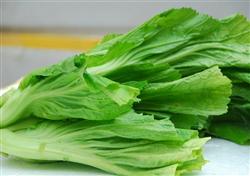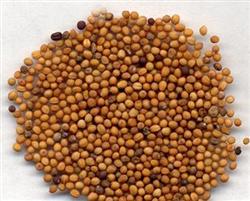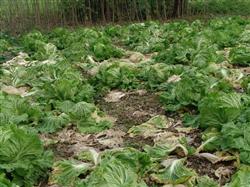Mustard planting: how to grow mustard for leaves?

How to grow leaves with mustard? What should we pay attention to when growing leaves with mustard? Please introduce the planting methods of leaf mustard as follows: first, the choice of mustard cultivation season: leaf mustard is not resistant to hot and cold, so it is suitable for cultivation in cool and humid climate. Early sowing can be at the end of August and early September, and late sowing can be in late September, generally waiting for the harvest from March to April of the following year. Leaf mustard has a yield of 6000Mustard per mu and a high yield of 12000 jin. It is appropriate to choose varieties that are not easy to bolting, raise seedlings in the cold bed and plant them after the final frost. The sowing date in autumn is earlier, the seedling stage is in a higher temperature environment, the growth rate and growth are increased, the root group develops well, and the yield can be increased. But early sowing in autumn, because the temperature is still high, and relatively dry, the harm of aphids is serious, and it is easy to spread virus disease, so the varieties with strong disease tolerance can be sowed early, while the varieties susceptible to disease can be sowed late. Second, the method of sowing and raising seedlings of leaf mustard: multi-row seedling and transplanting of leaf mustard. The seedbed should be far away from the vegetable base, especially from cruciferous vegetables, in order to reduce the virus disease transmitted by aphids. The soil should choose the loam with good water conservation and fertilizer conservation, the sandy soil heats up quickly and loses water quickly, which does not meet the requirements of leaf mustard like stable and moist soil, and is easy to lead to the occurrence of virus disease. After the seedling bed soil is ploughed, it should be fully exposed to the sun, and 45000 kg of compost and phosphate fertilizer and plant ash should be applied per hectare as base fertilizer to make the soil loose and nutritious so as to facilitate the growth of seedlings. Rake flat before sowing, make a border with a width of 1.3 meters and a height of 15 centimeters, and pour enough bottom water. The seed is 50 grams per mu and the sowing amount is 0.5 kilograms per mu. Early autumn sowing due to hot climate or showers, affecting seedling emergence and seedling growth, sowing amount can be appropriately increased; late sowing due to mild climate, high seedling rate, can be appropriately reduced. The seedlings raised in each mu of seedling bed are about 15-20 mu for planting. After sowing, it is covered with fine soil, about 0.5 cm thick. Early sowers should cover grass to moisturize and prevent Rain Water from solidifying the soil and hindering seedling emergence. The mulch must be removed in time when the seedlings begin to emerge. The first interseedling was carried out when the first true leaf appeared, and when the true leaf was 2-3, the seedling spacing was about 15 cm, and dilute liquid fertilizer was applied. Special attention should be paid to thorough control of aphids at seedling stage in order to alleviate viral diseases. Third, the transplanting method of leaf mustard: leaf mustard is not strict on soil, and can be cultivated in all kinds of soil, but in the season or area with high temperature, it is better to choose loam with water and fertilizer conservation and moist soil. Sand soil water conservation and fertilizer conservation is not good, easy to heat up, prone to virus disease, and poor plant growth. The row and plant spacing of planting varies from variety to variety. In general, the row spacing of early-maturing species and plant expansion is 33-40 cm and 25-33 cm, while that of middle and late-maturing species is 40-46 cm and 25-33 cm respectively. Leaf mustard takes root slowly after planting. The survival rate after planting is related to whether the seedlings are strong or not and the planting techniques. During planting, the roots should be damaged as little as possible, and the roots should not be twisted and suspended. It is necessary to make the roots stretch in the soil layer to facilitate growth. The root water should be irrigated in time after planting. Generally, 10000 plants are transplanted per mu and 6000 plants are interplanted in cotton fields. Fourth, the field management of leaf mustard: there are more overcast and rainy weather in autumn and winter, generally not irrigation, but also pay attention to drainage. Leaf mustard is fed by leaves, and nitrogen fertilizer should be used as the main fertilizer, but it should also be properly combined with phosphorus and potassium fertilizer to enhance disease resistance and increase yield, especially for leaf mustard with hypertrophic middle rib and petiole as the main products. In general, in addition to 15000 kg of base fertilizer per hectare, 300,450kg of calcium superphosphate and 1500-2250 kg of plant ash, topdressing should be applied 3-4 times during the growing period. From the colonization to survival to the product organ hypertrophy before the application of 2-3 times, from light to thick, about 60000 kg of animal dung, urea 300,450kg. Ploughing and weeding was carried out before fertilization. Leaf mustard cultivated in early autumn should be fertilized in time because of its high temperature and fast growth. It is not suitable to apply fertilizer in cold winter, otherwise it is vulnerable to freezing injury. Late-maturing varieties should be fertilized and irrigated in time after warm spring to avoid early bolting. Stop topdressing and irrigation before harvest to avoid excessive water content of the product. 5. Harvest of leaf mustard the late-maturing species sown in autumn and sown in late autumn are harvested from February to April. The appropriate time for harvest should meet the requirements of processing. It should be harvested after it is fully fattened and mature. The processed leaf mustard has its own harvest standard according to the type of processed vegetables, such as Guizhou pickle, which is harvested when the stem is short, the flower stalk is fat, strong, crisp and tender, and the petiole is fully hypertrophic. Sichuan Yibin sprout mustard is harvested before the petiole and middle rib are fully enlarged and the flower stalk is not drawn. The raw material of winter vegetables in Nanchong should be harvested before the stalk is 7-16 cm high and the flower stalk is not yet out. The heading mustard was harvested in real time in the leaf bulb. Click to get more mustard planting techniques click to get more vegetable planting techniques
- Prev

Mustard planting: what should you pay attention to when planting mustard?
What should I pay attention to when growing mustard? The farming network summarizes three key points that need to be paid attention to in mustard cultivation for netizens' reference. Note 1. Sowing and raising seedlings: mustard is generally raised first and then planted. However, as a fast-growing cultivation, direct seeding is mostly used, and some seedlings are planted after transplanting. Mustard seeds are small and young.
- Next

Mustard planting: what harm does soft rot do to mustard?
What harm does soft rot disease have to mustard? What method can prevent mustard soft rot? It is also hoped that experienced netizens can help introduce the harm of soft rot to mustard: mustard soft rot is a bacterial disease, which usually begins to occur in the late growth stage of mustard; at the beginning of the disease, the outer leaves of the plant wilt, and can recover sooner or later. ...
Related
- Where is it suitable to grow horseradish in China? it is expected to see the middle altitude horseradish in Alishan.
- How to prevent tomato virus disease reasonably? (Control methods included)
- Many people like to plant towel gourd on the balcony. What are the main points of this method and management?
- What crops can chili peppers be mixed with?
- Fertilization techniques and matters needing attention in Tomato
- What are the grafting techniques for peach seedlings in spring?
- Harm and control methods of root swelling disease of Chinese cabbage
- What are the pests of sweet potatoes? How to prevent and cure it?
- Symptoms, causes and Control methods of navel Rot in Tomato
- The cause of "Cucumber rotten bibcock" in Farmers' planting Cucumber and its Control Plan

